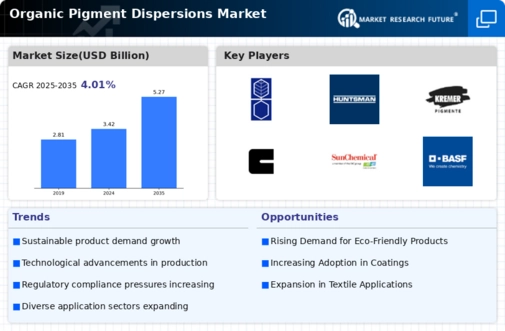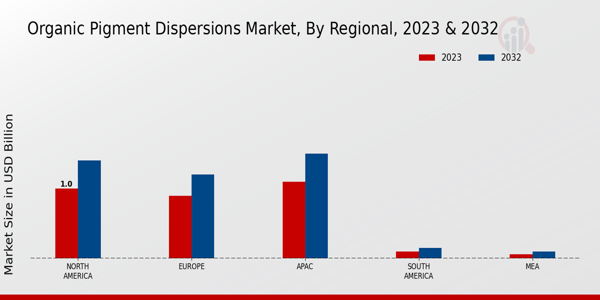Market Growth Projections
The Global Organic Pigment Dispersions Market Industry is projected to experience substantial growth over the next decade. With an anticipated market value of 3.42 USD Billion in 2024, the industry is set to expand significantly, reaching an estimated 5.27 USD Billion by 2035. This growth trajectory suggests a robust compound annual growth rate (CAGR) of 4.02% from 2025 to 2035. Such projections indicate a strong demand for organic pigments, driven by various factors including regulatory support, technological advancements, and increasing consumer awareness. The market's expansion reflects a broader trend towards sustainability and eco-friendly practices across multiple industries.
Growing Demand for Eco-Friendly Products
The Global Organic Pigment Dispersions Market Industry experiences a notable increase in demand for eco-friendly products. As consumers become more environmentally conscious, manufacturers are compelled to adopt organic pigments that are less harmful to the environment. This shift is evident in various sectors, including paints, coatings, and plastics, where organic pigments are preferred for their lower toxicity and biodegradability. The market is projected to reach 3.42 USD Billion in 2024, reflecting a growing trend towards sustainable practices. This demand is likely to drive innovation and investment in organic pigment technologies, further enhancing the market's growth potential.
Rising Applications in Various Industries
The Global Organic Pigment Dispersions Market Industry benefits from a broadening range of applications across multiple sectors. Industries such as textiles, automotive, and construction are increasingly utilizing organic pigments due to their vibrant colors and environmental benefits. For instance, the textile industry is shifting towards organic pigments for dyeing processes, which aligns with consumer preferences for sustainable fashion. This diversification of applications not only expands the market reach but also enhances the overall demand for organic pigments. As industries continue to explore the benefits of organic pigments, the market is poised for sustained growth in the coming years.
Regulatory Support for Sustainable Practices
Regulatory frameworks globally increasingly favor sustainable practices, significantly impacting the Global Organic Pigment Dispersions Market Industry. Governments are implementing stringent regulations to limit the use of harmful chemicals in manufacturing processes. For instance, the European Union's REACH regulation encourages the use of safer alternatives, including organic pigments. This regulatory support not only promotes the adoption of organic pigments but also incentivizes manufacturers to invest in research and development. Consequently, the market is expected to grow, with projections indicating a rise to 5.27 USD Billion by 2035, driven by compliance with these regulations.
Technological Advancements in Pigment Production
Technological advancements play a crucial role in shaping the Global Organic Pigment Dispersions Market Industry. Innovations in production techniques, such as nanotechnology and improved dispersion methods, enhance the performance and application of organic pigments. These advancements lead to better color strength, stability, and compatibility with various substrates. As a result, manufacturers can produce high-quality organic pigments that meet diverse industry requirements. This trend is likely to contribute to a compound annual growth rate (CAGR) of 4.02% from 2025 to 2035, as companies increasingly adopt these technologies to remain competitive in the market.
Consumer Awareness and Preference for Healthier Options
Consumer awareness regarding health and safety is a driving force in the Global Organic Pigment Dispersions Market Industry. As individuals become more informed about the potential risks associated with synthetic pigments, there is a marked shift towards organic alternatives. This trend is particularly evident in sectors such as food packaging and cosmetics, where the demand for non-toxic and safe products is paramount. Manufacturers are responding by reformulating products to include organic pigments, thereby catering to this growing consumer preference. This shift not only enhances brand loyalty but also contributes to the overall expansion of the market.









